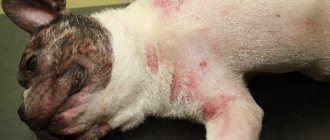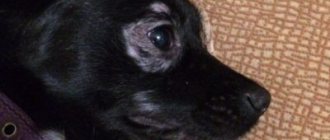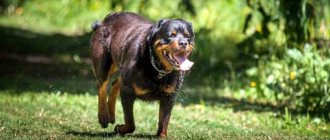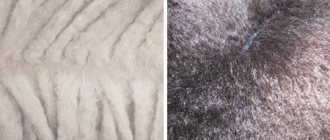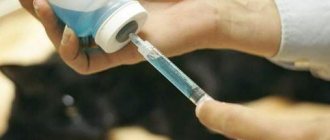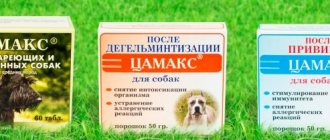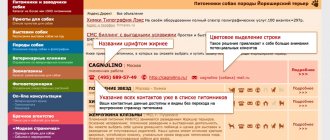Seasonal shedding in dogs of almost all breeds is completely normal. It occurs in the spring, when the body renews itself and “frees itself” from old hair that has lost density and elasticity.
Shedding can be protracted if the animal has been sick for a long time or has undergone surgery. Also, the process can be lengthy if there is a deficiency of vitamins in its food, especially vitamin A and group B. But when molting, the coat can thin out without baldness and the appearance of inflamed, irritated areas of the skin.
If the dog reacts painfully to touch, whines, itches, and its skin is inflamed, with traces of suppuration, scars, dandruff or signs of flaking, we are talking about the presence of a disease. And this already requires a visit to the veterinary clinic.
Causes of the disease
If natural causes of hair loss are excluded, then the causes of dog baldness
there may be the following:
- Violations in hygienic care of animals.
- A sharp decrease in immunity.
- Malnutrition.
- Lack of vitamins.
- Elderly age.
- Metabolic disorders.
- Allergies to food or external sources.
- Hormonal imbalances.
- The presence of helminths in the body.
- Skin infections of a fungal or bacterial nature.
- Subcutaneous mites.
Since there are many reasons for hair loss, and the symptoms are similar, only a veterinarian can identify the true disease that led to the problem when examining the animal.
Therefore, if simple shedding is excluded, and there are reasons to suspect the presence of a disease, you need to take the dog to the clinic as quickly as possible.
Lack of nutrition
Shreds of hair can fall out from a dog either due to general exhaustion and nutritional deficiency, or due to a lack of a number of essential elements. A general lack of nutrients can be determined by the clinical picture, but to make a diagnosis and select the correct treatment, it is necessary to do a biochemical blood test.
Clinical signs of deficiency of various vitamins:
- A-vitaminosis is accompanied by follicular hyperkeratosis, poor coat condition, and scales on a large surface of the body;
- vitamin B7 deficiency leads to hair loss around the eyes, crusting on the face, general lethargy and diarrhea;
- lack of nicotinic acid leads to dermatitis, ulceration of the mucous membranes, and pleurisy.
For treatment, it is necessary to normalize the dog’s diet. First of all, additional vitamin feed is introduced. It is also recommended to make intramuscular injections of complex vitamins and microelements.
Which breeds are more susceptible
Absolutely any dog can get sick, but dogs that are long-haired and have folds of skin along their body are more susceptible to baldness and coat problems. These are Mastino Napolitano, Bullmastiff, Dogue de Bordeaux, Chow Chow, Shar Pei, Boxer, English and French bulldogs, Pug, Chihuahua and some other breeds.
Due to their anatomy, large folds of skin can rot, accumulate infection, become inflamed and lead to the development of diseases in which the coat becomes very thin or falls out altogether.
Hormonal disorders
Disturbances in the hair follicle cycle accompany most endocrine diseases and often lead to baldness:
- An increased content of estrogen - hyperestrogenism - makes the hair dull, brittle, the epidermis - thin, and the growth of new hair is delayed.
- The adrenocorticotropic hormone of the pituitary gland inhibits the development of fur.
- Hypothyroidism - a deficiency of thyroid hormones - leads to fragility of the skin, symmetrical alopecia, starting from the tail.
- In diabetes, metabolism is disrupted, the coat becomes dull and falls out.
Non-inflammatory alopecia due to endocrine disease
Alopecia due to hormonal imbalance is usually symmetrical.
Main symptoms
An attentive owner will immediately notice that the dog is behaving inappropriately:
- The animal is restless, cannot sleep peacefully, often jumps off, itches, and may whine and howl.
- Scratch marks appear on the skin, and the vegetation thins out.
- In those places that are devoid of hair, inflamed, swollen areas appear, which can look like inflamed wounds or even like purulent wounds.
- If the affected area is around the eyes, they may become inflamed, swollen, and mucous or purulent discharge may appear.
- The most commonly affected areas of the body are the muzzle, armpits, inguinal folds, genital area, undertail and abdomen.
- The dog may lose his appetite and not even respond to his favorite dish or tasty brain bone.
- When trying to examine a sore spot, the dog becomes aggressive and can even bite a person, including its own owner.
- If the skin is severely damaged, the animal's temperature rises, it becomes lethargic, apathetic, lies indifferently, or even tries to hide in a corner.
Before taking measures, you must undergo an examination in a clinic, since skin diseases are not always the cause of baldness. Such problems need to be treated “from the inside”, and only a doctor can identify them.
What is dandruff in dogs and what does it look like?
Dandruff on a dog's coat looks like small scales of a light shade, dry or, conversely, greasy. These are dead particles of the epidermis, the top layer of skin. A certain amount of them is normal: skin cells are constantly renewed, and dried dead particles flake off from the surface. Sometimes dandruff appears on a dog’s body during shedding: if it disappears after it and does not cause discomfort to the animal, there is most likely no problem. However, a person should be wary if:
- dandruff appears not only when the animal sheds;
- peeling is very active, and a large number of scales are visible to the naked eye;
- the surface affected by dandruff is constantly increasing and covers large areas of the body;
- areas of peeling are localized and located in the tail area or on the back;
- you notice black scales;
- the animal shows discomfort and often itches;
- For some reason, the dandruff moves, the particles are oval in shape and are firmly stuck to the hair;
- The hair on the affected areas began to fall out and climb.
Diagnostics in a veterinary clinic
An experienced veterinarian can identify some characteristic signs of a particular disease by appearance, but to obtain an accurate diagnosis you will still have to undergo an examination and pass the necessary tests.
First of all, the clinic will rule out ticks, fungal and bacterial infections. The cause of hair loss on a dog's body can be eczema, pyoderma, lack of vitamins or general exhaustion.
Also, wool actively sheds after childbirth, severe or prolonged illness, or surgery. During the examination, the doctor will definitely find out these circumstances from the animal owner.
Only after an accurate diagnosis has been made will the veterinarian prescribe the necessary treatment and select the right medications.
CLASSIFICATION OF BALDING
There is no generally accepted classification system for alopecia in pets; different sources divide the types of the disease in their own way. Experts agree that canine alopecia can be divided into three types, which also have their own subtypes:
- According to etiology, they are divided into 2 subtypes: inflammatory and non-inflammatory;
- Localization classification is divided into 4 subtypes: nested, telogen, mirror or multifocal;
- Genetics: hereditary and acquired (Alopecia X).
Veterinarians use this classification of the disease to make an accurate diagnosis in accordance with the standards.
Treatment method and prognosis
Owners of sick dogs need to understand that using medications intended for humans can be very dangerous and harmful to the dog. You can only use medications prescribed by a veterinarian and strictly in the prescribed dosage.
The method of treatment and choice of medications depends entirely on the cause of the loss. If the cause is a bacterial infection, the dog will be prescribed a course of antibiotics. If the dog is infected with fungi, lichen or mites, it will be necessary to undergo specialized treatment, which usually includes a course of medications internally and the use of ointments, creams or powders externally.
In case of hormonal disorders, the doctor can select the appropriate treatment to correct the condition. Often, with recurring problems, owners are advised to sterilize the animal in order to rid it of hormone swings and avoid recurrence of hair loss.
If there is an acute shortage of vitamins, you need to adjust the dog’s menu, saturating it with the necessary substances. In case of allergies, the allergen is identified and the dog is isolated from it. Sometimes hair loss occurs due to an excess of protein in the diet. In this situation, it is necessary to change the diet by cutting down on proteins and adding more vegetables and cereals to the dog’s food.
Hair loss around the tail and genitals is often caused by the presence of helminths. Some of them lay eggs outside the body: on the delicate skin of the genitals and in the folds of the anus. The dog scratches these places, infection gets into the abrasions, and inflammation with swelling occurs.
As the infection spreads, it causes damage to the hair follicles, and the hair in the affected areas falls out - partially or completely. In this case, the treatment will be twofold. First, it is necessary to carry out deworming, eliminating the cause of the itching. Then the inflamed areas of the skin are treated.
Most often, a bacterial infection settles in scratches, so the dog is prescribed a course of antibiotics and ointments with them externally. In most cases, hair loss can be dealt with quickly, the infection goes away and the hair grows back - thick, dense and elastic.
Sometimes owners themselves become the cause of their pet's illness. An excessive desire for cleanliness is just as harmful as a complete disregard for hygiene. If you wash your dog too often, the skin and hair's defenses will be weakened and unable to resist. The hair will dry out and break, and the skin will peel off. As a result, bald spots and flaking similar to dandruff may appear in the coat.
To get rid of this condition, you need to stop tormenting your dog with constant washing and use exclusively shampoos and other products for animals, and not aromatic gels for people. In addition, with severe dry skin and coat, as with baldness in aging dogs, you need to enrich the menu with healthy polyunsaturated fatty acids and vitamins.
Hair loss during shedding
Dog hair lasts a certain period of time, after which it falls out, and a new one grows in its place. In most cases, this is a natural process, even if the fur comes out in clumps. Depending on the type of keeping and other external factors, dogs have several types of shedding:
- seasonal;
- age;
- continuous;
- pathological
The first moult in puppies results in the replacement of soft juvenile hair with coarser adult hair. Then twice a year dogs experience seasonal shedding. Under the influence of external stimuli (lighting, temperature), endocrine regulation is triggered, triggering the growth of the undercoat and longer guard hair. A similar procedure occurs in the spring, when downy hair begins to fall out. Seasonal molting lasts for several weeks (up to 1.5-2 months) and begins from the head, gradually moving along the back to the tail and limbs.
In animals kept in warm apartments throughout the year, seasonal molting is not pronounced. Instead, hair falls out as the follicles age and die. This coat change is not noticeable, but can intensify under various external influences. In this case, pathological molting develops, which is associated with parasitic, infectious and other diseases.
What to do at home
The dog should be treated only as prescribed by a doctor, without doing anything on your own. At home, a sick dog needs to be provided with a dry, clean and warm place where no one will disturb it. The bedding must be changed regularly, washed thoroughly and ironed if a tick or fungal or bacterial infection is detected on the dog.
Medicines are given as prescribed by the veterinarian. The dog is provided with high-quality food, clean water, and care is taken to ensure that it does not become depressed or experience severe discomfort.
If the animal scratches its wounds, it will have to wear a special protective collar. Owners will have to carefully treat diseased areas of the skin in order to quickly achieve healing and the growth of a healthy shiny coat.
Allergies
What are dogs allergic to? The likelihood that a dog could be allergic to a hundred different substances in the room where it lives is very high; and this does not even take into account the microscopic particles of allergens in the air that she inhales. Food, carpets, blankets, dust mites, mold spores in the air, pollen, plastic, furniture, houseplants can all cause an allergic reaction in dogs.
Food allergies are so common that pet food manufacturers have invested millions into developing hypoallergenic diets to help treat dogs with food allergies. Treatment of allergic dermatitis is carried out using modern medicated shampoos, ointments and sprays. The use of oral antihistamines can neutralize the occurrence of allergies.
Possible complications
Any disease, if left untreated or if it is chosen incorrectly, can become complicated. In the case of skin diseases with infection, this threatens the dog with the spread of the disease, including general blood poisoning.
If the cause of hair loss is a food allergy, continuing to feed your dog the same food can be fatal. This will lead to disruption of the functioning of internal organs, digestive disorders and the most dangerous consequences, including death.
Extensive damage to the dog’s fur threatens the development of severe infections and their spread throughout the body.
Source of melatonin
Melatonin is easily synthesized and is therefore a fairly inexpensive hormone that is administered orally (as tablets or capsules) or systemically using subcutaneous injections or long-acting subcutaneous implants. Interestingly, melatonin is also present naturally in some plants. However, to absorb 3 mg of melatonin, you would need to eat 120 bananas or 30 large bowls of rice!
Melatonin tablets are sold over the counter in pharmacies and health products in the United States and some other countries, where it is considered more of a dietary supplement than a drug (so it is not regulated as such). Melatonin is available in 2 or 3 mg tablets under several trade names. However, only licensed products guarantee quality. Melatonin crystal powder is also made into capsules. The main problem with oral melatonin is its short half-life and dose-dependent bioavailability. In one study, after administration of 3 mg/kg IV, its half-life in dogs was 18.6 minutes. Thanks to the Rickards Research Foundation, injectable liquid melatonin (made from crystalline melatonin powder dissolved in ethanol and mixed with water and DMSO) has been available for several years. It has been used in the past to treat acanthosis nigricans (Scott et al., 1995). This could be a valuable option, although pharmacokinetic data on this are lacking. Long-acting implants containing 2.5 mg and 12 mg melatonin have been approved in several countries for use in mink and foxes, respectively. They are produced by WildlifePharmaceuticals. Unfortunately, some dogs that have received subcutaneous implants have developed sterile abscesses or granulomas at the implantation site. This is common in dogs; In the fur industry, more than 10 million minks and foxes received subcutaneous melatonin implants and there was no evidence of local adverse reactions.
Scarring alopecia
Scarring of injured, deeply infected skin damages the integrity of the coat irrevocably. The mouths of the hair follicles, covered with fibrous tissue, disappear.
Scarring alopecia in a boxer
Causes of cicatricial alopecia:
- prolonged squeezing, wiping the skin (for example, baldness of the neck under the collar, as well as the elbow joints - from hard bedding or lack thereof);
- burns (including frostbite);
- tissue necrosis from deep infected wounds;
- severe purulent inflammation.
Post-burn scars are eliminated plastically, if the location of the damage and the condition of the animal allows.
